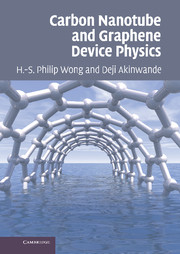Book contents
- Frontmatter
- Contents
- Preface
- 1 Overview of carbon nanotubes
- 2 Electrons in solids: a basic introduction
- 3 Graphene
- 4 Carbon nanotubes
- 5 Carbon nanotube equilibrium properties
- 6 Ideal quantum electrical properties
- 7 Carbon nanotube interconnects
- 8 Carbon nanotube field-effect transistors
- 9 Applications of carbon nanotubes
- Index
2 - Electrons in solids: a basic introduction
Published online by Cambridge University Press: 05 June 2012
- Frontmatter
- Contents
- Preface
- 1 Overview of carbon nanotubes
- 2 Electrons in solids: a basic introduction
- 3 Graphene
- 4 Carbon nanotubes
- 5 Carbon nanotube equilibrium properties
- 6 Ideal quantum electrical properties
- 7 Carbon nanotube interconnects
- 8 Carbon nanotube field-effect transistors
- 9 Applications of carbon nanotubes
- Index
Summary
Free your mind.
Introduction
The central purpose of this book is to understand the properties of electrons in CNTs and graphene. A good understanding is of utmost importance because it enables us to make electronic devices and engineer the performance of the devices to satisfy our desires. These devices can include, for example, sensors, diodes, transistors, transmission lines, antennas, and electron emission devices. In addition, the devices made out of carbon nanomaterials are being considered as building blocks for future applications broadly referred to as nanoelectronics, which includes circuits and systems. The technology to make nanomaterials and related devices is called nanotechnology.
To accomplish our central purpose, it is essential that we are familiar with the mathematical techniques and physical ideas behind the theory of electrons, particularly in solids. Specifically, in order to understand and describe the behavior of electrons in a solid requires consideration of:
(i) The general quantum mechanical wave nature of electrons.
(ii) The periodic arrangement of atoms in crystalline solid matter, which is frequently called the crystal structure or lattice.
The introductory discussion of electrons in solids in this chapter will proceed in a manner that is beneficial for developing intuition, by considering an introductory quantum mechanical description of electrons, and subsequently exploring the crystal structure. Our attention throughout the chapter will be focused on the mathematical techniques, central ideas, and main results regarding electrons in solids. In view of the fact that quantum mechanics and solid-state physics are themselves fundamental disciplines of physics of great breadth and depth, this chapter is primarily intended as an elementary review of the minimum basic concepts and techniques in the quantum mechanical description of electrons in solids.
- Type
- Chapter
- Information
- Carbon Nanotube and Graphene Device Physics , pp. 19 - 46Publisher: Cambridge University PressPrint publication year: 2010



